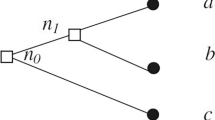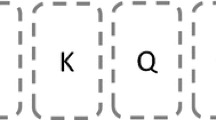Abstract
The aim of this paper is to propose a preferences representation model where ambiguity attitudes can be exogenous events or past experience-dependent. We adapt the Recursive Smooth Ambiguity model proposed by Klibanoff (Journal of Economic Theory 144:930-976, 2009) by introducing past experience described by a sequence of neutral events occurring up to the moment of the decision. These neutral events do not provide any information on the true process, but are likely to strengthen or weaken the decision-maker’s ambiguity aversion degree by modifying emotions. Our model can explain some observed behaviors and market inefficiencies. We propose two illustrations. First, we provide a behavioral explanation for the decrease in influenza vaccination in France that followed the H1N1 crisis in 2009–2010. Second, we contribute to the broad literature on the annuity puzzle by introducing the impact of emotions on ambiguity attitudes.





Similar content being viewed by others
Notes
See Klibanoff et al. (2009), example 1 page 26.
A cylinder set describes a generalized outcome of the joint event \((x_t,e_t)\) defined by the event base \(\mathcal {A}_t\).
The payoff space \(\mathcal {C}\) is assumed to be a compact interval in \(\mathbb {R}\) endowed with standard topology of the real line.
See OECD (2023)
In France, this is the case for at-risk population.
The assumption of side effects lead to lower health status than the disease itself allows for a focus on non-trivial optimal behaviors.
Although the life annuity contract proposed by Yaari (1965) is optimal, many studies showed that the demand for annuities is very low: that constitutes “the annuity puzzle”.
See Alexandrova and Gatzert (2019) for a recent review on annuitization decision.
For simplicity, we denote by \(\phi _i\) the function \(\phi _{e_i}\).
References
Alary, D., Gollier, C., & Treich, N. (2013). The Effect of Ambiguity Aversion on Insurance and Self-protection. The Economic Journal, 123(573), 1188–1202.
Alexandrova, M., & Gatzert, N. (2019). What do we know about annuitization decisions? Risk Management and Insurance Review, 22(1), 57–100.
Andrade, E. B., & Ariely, D. (2009). The enduring impact of transient emotions on decision making. Organizational behavior and human decision processes, 109(1), 1–8.
Baillon, A., Koellinger, P., & Treffers, T. (2016). Sadder but wiser: the effects of affective states on ambiguity attitude. Journal of Economic Psychology, 53, 67–82.
Banks, J., Bassoli, E., & Mammi, I. (2020). Changing attitudes to risk at older ages: The role of health and other life events. Journal of Economic Psychology, 79, 102208.
Barberis, N., & Thaler, R. (2003). A survey of behavioral finance. In G. M. Constantinides, M. Harris, & R. M. Stulz (Eds.), Handbook of the Economics of Finance (1st ed., Vol. 1, pp. 1053–1128). Elsevier. chapter 18.
Bartholomeyczik, K., Gusenbauer, M., & Treffers, T. (2022). The influence of incidental emotions on decision-making under risk and uncertainty: a systematic review and meta-analysis of experimental evidence. Cognition and Emotion, 36(6), 1054–1073.
Battigalli, P., & Dufwenberg, M. (2022). Belief-dependent motivations and psychological game theory. Journal of Economic Literature, 60(3), 833–882.
Berger, L., Bleichrodt, H., & Eeckhoudt, L. (2013). Treatment decisions under ambiguity. Journal of Health Economics, 32, 559–569.
Berger, L., Emmerling, J., & Tavoni, M. (2017). Managing Catastrophic Climate Risks Under Model Uncertainty Aversion. Management Science, 63(3), 749–765.
Bosman, R., & Van Winden, F. (2002). Emotional hazard in a power-to-take experiment. The Economic Journal, 112(476), 147–169.
Bossaerts, P., Ghirardato, P., Guarnaschelli, S., & Zame, W. R. (2010). Ambiguity in asset markets: Theory and experiment. Review of Financial Studies, 23(4), 1325–1359.
Caliendo, M., Cobb-Clark, D. A., & Uhlendorff, A. (2015). Locus of control and job search strategies. Review of Economics and Statistics, 97(1), 88–103.
Cohen, M., Etner, J., & Jeleva, M. (2008). Dynamic Decision Making when Risk Perception Depends on Past Experience. Theory and Decision, Springer Verlag, 64(2–3), 173–192.
Cohn, A., Engelmann, J., Fehr, E., & Maréchal, M. A. (2015). Evidence for Countercyclical Risk Aversion: An Experiment with Financial Professionals. American Economic Review, 105(2), 860–885.
Collard, F., Mukerji, S., Sheppard, K., & Tallon, J. M. (2018). Ambiguity and the Historical Equity Premium. Quantitative Economics, 9(2), 945–993.
Courbage, C., & Peter, R. (2021). On the effect of uncertainty on personal vaccination decisions. Health Economics, 30(11), 2937–2942.
D’Albis, H., & Etner, J. (2018). Illiquid Life Annuities. Journal of Public Economic Theory, Wiley, 20(2), 277–297.
D’Albis, H., & Thibault, E. (2018). Ambiguous life expectancy and the demand for annuities. Theory and Decision, Springer, 85(3), 303–319.
Decker, S., & Schmitz, H. (2016). Health shocks and risk aversion. Journal of health economics, 50, 156–170.
Dominiak, A., & Eichberger, J. (2021). Games in context: Equilibrium under ambiguity for belief functions. Games and Economic Behavior, 128, 125–159.
Dillenberger, D., & Rozen, K. (2015). History-dependent risk attitude. Journal of Economic Theory, 157, 445–477.
Eichberger, J., Grant, S., & Kelsey, D. (2020). Strategic ambiguity in multi-stage games with almost perfect information. Working Paper.
Ert, E., & Trautmann, S. T. (2014). Sampling experience reverses preferences for ambiguity. Journal of Risk and Uncertainty, 49, 31–42.
Goodell, J. W., Kumar, S., Rao, P., & Verma, S. (2022). Emotions and stock market anomalies: a systematic review. Journal of Behavioral and Experimental Finance, 100722.
Gollier, C. (2011). Portfolio choices and asset prices: The comparative statics of ambiguity aversion. The review of Economic Studies, 78(4), 1329–1344.
Guiso, L., Sapienza, P., & Zingales, L. (2018). Time Varying Risk Aversion. Journal of Financial Economics, 128(3), 403–421.
Kaustia, M., & Rantapuska, E. (2016). Does mood affect trading behavior? Journal of Financial Markets, 29, 1–26.
Klibanoff, P., Marinacci, M., & Mukerji, S. (2009). Recursive smooth ambiguity preferences. Journal of Economic Theory, 144(3), 930–976.
Lerner, J. S., & Keltner, D. (2000). Beyond valence: Toward a model of emotion-specific influences on judgement and choice. Cognition and emotion, 14(4), 473–493.
Lerner, J. S., & Keltner, D. (2001). Fear, anger, and risk. Journal of personality and social psychology, 81(1), 146.
Lerner, J. S., & Tiedens, L. Z. (2006). Portrait of the angry decision maker: How appraisal tendencies shape anger’s influence on cognition. Journal of behavioral decision making, 19(2), 115–137.
Lerner, J. S., Li, Y., Valdesolo, P., & Kassam, K. (2015). Emotion and Decision Making. Annual Review of Psychology, 66, 799–823.
Li, Z., Müller, J., Wakker, P. P., & Wang, T. V. (2018). The rich domain of ambiguity explored. Management Science, 64(7), 3227–3240.
Loewenstein, G. F., & Lerner, J. S. (2003). The Role of Affect in Decision Making. In R. J. Davidson, K. R. Scherer, & H. H. Goldsmith (Eds.), Handbook of Affective Sciences (pp. 619–642). New York, NY: Oxford University Press.
Maafi, H. (2011). Preference Reversals Under Ambiguity. Management Science, 57(11), 2054–2066.
McGee, A. D. (2015). How the perception of control influences unemployed job search. Ilr Review, 68(1), 184–211.
Meier, A. N. (2022). Emotions and risk attitudes. American Economic Journal: Applied Economics, 14(3), 527–58.
Millner, A., Dietz, S., & Heal, G. (2013). Scientific Ambiguity and Climate Policy. Environ Resource Econ, 55, 21–46.
Nguyen, Y., & Noussair, C. N. (2014). Risk aversion and emotions. Pacific economic review, 19(3), 296–312.
OECD. (2023). Influenza vaccination rates (indicator). https://doi.org/10.1787/e452582e-en. (Accessed on 10 January 2023)
Schelling, T. C. (1960). The Strategy of Conict. Harvard University Press.
Schwarz, N. (2012). Feelings-as-Information Theory. In: Van Lange, Paul A. M., Kruglanski, Arie W., & Higgins, E. Tory (Eds.), Handbook of Theories of Social Psychology. Chapter 14. London:Sage.
Shupp, R., Loveridge, S., Skidmore, M., et al. (2017). Risk, Loss, and Ambiguity Aversion after a Natural Disaster. EconDisCliCha, 1, 121–142.
Tserenjigmid, G. (2019). History-Dependent Risk Aversion, the Reinforcement Effect, and Dynamic Monotonicity. Working paper.
Wakker, P. (1989). Additive representations of preferences, a new foundation of decision analysis. Dordrecht: Kluwer (Academic Publishers).
Yaari, M. E. (1965). Uncertain Lifetime, Life Insurance, and the Theory of the Consumer. Review of Economic Studies, 32(2), 137–150.
Author information
Authors and Affiliations
Corresponding author
Additional information
Publisher's Note
Springer Nature remains neutral with regard to jurisdictional claims in published maps and institutional affiliations.
Appendices
Appendices
1.1 Standard assumptions in Klibanoff et al. (2009)
Assumption 1
(Weak Order) For all \(s^t \in \mathcal {S}^t\), \(\succeq _{s^t}\) on \(\mathcal {F}\) is complete and transitive.
Assumption 2
(Monotonicity) Given any \(f,g \in \mathcal {F}\), if \(f(s) \geqslant g(s)\) for all \(s\geqslant s^t\), then \(f \succeq _{s^t} g\). If, in addition, f and g are deterministic and \(f(\tau ) > g(\tau )\) for at least some \(\tau \geqslant t\), then \(f \succ _{s^t} g\).
Assumption 3
(Archimedean) For all \(s^t \in \mathcal {S}^t\), \(\forall f \in \mathcal {F}\) and \(\forall c_1,c_2 \in \mathcal {C}\), if \(c_1 \succ _{s^t} f \succ _{s^t} c_2\), then there exist \(\alpha , \beta \in ]0;1[\) such that \(\alpha c_1+(1-\alpha ) c_2 \succ _{s^t} f \succ _{s^t} \beta c_1+(1-\beta ) c_2 \).
Assumption 4
(Dynamic Consistency) \(\forall s^t \in \mathcal {S}^t\), \(\forall f,g \in \mathcal {F}\), if \(f(s^t)=g(s^t)\), then \(f \succ _{s^t,(x_{t+1},e_{t+1})}g,\) \(\forall (x_{t+1},e_{t+1}) \Rightarrow f \succ _{s^t}g\)
Assumption 5
(Discounting) For each deterministic continuation plan \(d_{s^t} \in \mathcal {D}_{s^t}\), there exists a plan \(f \in \mathcal {F}\) with \(f_{\mid _{s^t}}=d_{s^t}\) and such that \(f \sim _{s^t}\{d_{s^t},1\}\). At each node \(s^t \in \mathcal {S}^t\), \(\succ _{s^t}\) on \(\mathcal {P}_t\) is represented by the expectation of a von Neumann–Morgenstern utility index \(U_{s^t}:\mathcal {D}_{s^t} \rightarrow \mathbb {R}\) which has the form
Assumption 6
(Invariance) \(\forall t,t^\prime \in T\cup \{0\}\), \(\forall p \in [0,1]\), and \(\forall c_i^{\prime },c_i^{\prime \prime },c_i, k_i^{\prime },k_i^{\prime \prime },k_i \in \mathcal {C}\) with \(i \in \{1,2\}\):
Assumption 7
(SEU on second order acts) There exists a unique (additive) probability \(\mu _{s^t}:2^\Theta \rightarrow [o,1]\) and a continuous, strictly increasing \(v: \mathcal {C} \rightarrow \mathbb {R}\) such that, for all \(\mathfrak {f}, \mathfrak {g} \in \mathfrak {F}\),
Moreover, v is unique up to positive affine transformations, provided \(0< \mu _{s^t}(J) < 1\) for some \(J \subseteq \Theta \).
Assumption 8
(Consistency with associated second order acts) Given \(f_{s^t},g_{s^t} \in \mathcal {F}_{s^t}^*\) and associated \(f^2,g^2 \in \mathfrak {F}\), if \(f_{s^t}(s^t)=g_{s^t}(s^t)\) then \(f \succ _{s^t}g \Leftrightarrow f ^2\succ _{s^t}^2\,g^2\) for all \(f,g \in \mathcal {F}\) such that \(f_{\mid _{s^t}}=f_{s^t}\) and \(g_{\mid _{s^t}}=g_{s^t}\).
Rights and permissions
Springer Nature or its licensor (e.g. a society or other partner) holds exclusive rights to this article under a publishing agreement with the author(s) or other rightsholder(s); author self-archiving of the accepted manuscript version of this article is solely governed by the terms of such publishing agreement and applicable law.
About this article
Cite this article
Etner, J., Jeleva, M. & Renault, O. Dynamic decision-making when ambiguity attitudes depend on exogenous events. Theory Decis 96, 269–295 (2024). https://doi.org/10.1007/s11238-023-09948-6
Accepted:
Published:
Issue Date:
DOI: https://doi.org/10.1007/s11238-023-09948-6




